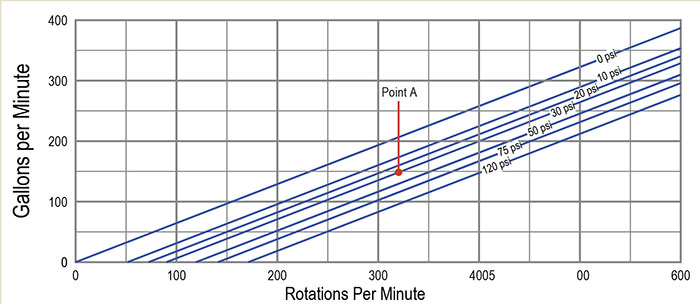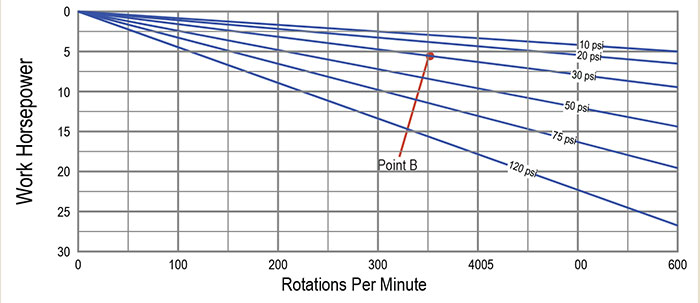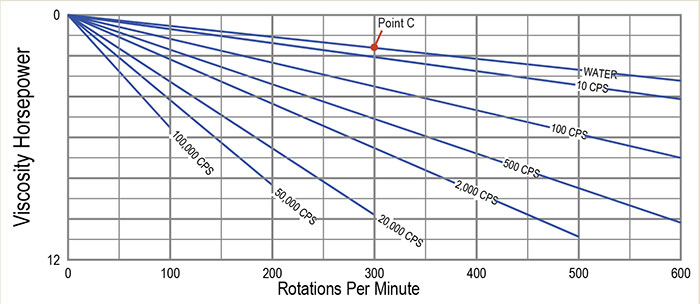Positive displacement (PD) pump technologies vary, as do the curves for these pumps. A person without significant exposure to pump selection is often experienced only with centrifugal pump curves. Therefore, it can be frustrating to get the data required from a positive displacement curve.
Though curves vary with differing technologies, the same process can be successfully applied.
In this article, we will walk step by step through a circumferential piston pump curve to identify the speed and horsepower (hp) needed to operate this pump and achieve a desired flow and pressure with a given fluid.
First, identify the plot on the performance curve that has vertical and horizontal axis displaying the speed (measured in rotations per minute [rpm]) and flow (measured in gallons per minute [gpm]) of the pump. On the sample curve shown in Image 1, speed is along the X-axis at the bottom and flow is along the Y-axis. The blue lines on this plot represent performance adjustments based on slip at a given pressure, in this case a range from 0 to 120 pounds per square inch (psi). Note that if the liquid is more viscous than water, the slip will be less than represented because there is more resistance in the clearances of the pump. For this example, the application requires 150 gallons per minute (gpm) at 30 psi of water or a product with water-like viscosity.
 Image 1. Speed in rpm vs. flow in gpm. All performance curves based on tests using 70 F water and 0 psig inlet pressure. A tolerance of plus or minus 5 percent applies to all figures. Actual performance may vary by application product. Please contact the manufacturer for different conditions. (Images courtesy of Crane Engineering)
Image 1. Speed in rpm vs. flow in gpm. All performance curves based on tests using 70 F water and 0 psig inlet pressure. A tolerance of plus or minus 5 percent applies to all figures. Actual performance may vary by application product. Please contact the manufacturer for different conditions. (Images courtesy of Crane Engineering)Now, identify the 150 gpm flow required on the X-axis and carry it over to the 30 psi blue line. When intersected (Point A), run a vertical line down toward the Y-axis. The sample curve indicates a water-like fluid against 30 psi.
Generating 150 gpm will require the pump operates at 300 rpm.
With the required speed identified, determine how much hp the pump will need to meet the application. Use the plots in Images 2 and 3 to calculate the total hp required. The X-axis on both of these plots represents the speed of the pump. Align the values and draw a line straight down to identify the 300 rpm on each.
 Image 2. Work horsepower plot
Image 2. Work horsepower plotImage 2 is the plot for work hp. This is the hp the pump will require to overcome the pressure on the discharge side. This is the sum of all the factors the pump needs to create pressure to overcome static head: friction losses of pipe, valves and strainers; pressure in a pipe or vessel that is being pumped into; etc.
In Image 1, there is a relationship between the flow, pressure and viscosity. The values for viscosity are absent but it is inherent that slip accounts for loss of performance in the presence and escalation of pressure since the curve is based on water at 70 degrees F. In this example, bring the 300 rpm line down until the blue 30 psi line is intersected at Point B. At this intersection, look to the Y-axis, in this case approximately 5 hp.
Add this to the hp indicated in Image 3 to get the total hp.
 Image 3. Viscosity horsepower plot
Image 3. Viscosity horsepower plotImage 3 shows the hp required to overcome friction losses within the pump based on a given product’s viscosity. Viscosity is the resistance to flow, so the higher the viscosity, the more hp required to operate. This example uses a water-like fluid with a viscosity close to 1 centipoise (cPs). Resistance is low. From Image 1, carry the 300 rpm speed straight down until it again intersects the blue line for the viscosity of the fluid being pumped. This plot has a line that indicates “WATER.” At this intersection, Point C, run a horizontal line to the Y-axis to determine the viscosity horsepower. In this case, the hp requirement is approximately 1.8 hp.
Add the 5 hp of working hp and 1.8 hp for viscosity hp to get a total hp required of 6.8 hp. Since there is a plus or minus 5 percent tolerance called out in the description, it is recommended to add a 5 percent safety factor. It is recommended to add at least a 15 percent safety factor in to cover unforeseen hp requirements from slightly higher than expected, or variation in, viscosity from temperature or other factors.

With only a 5 percent safety factor, this indicates a 7.5-hp motor should be selected. A 15 percent safety factor on the selection calculated would be 8 hp, so a 10-hp motor would be provided.
With the selection complete, the user can size the motor correctly and make a selection that will vary the speed from motor speed—whether it be a gear reducer, belts and sheaves, or a variable speed drive (VSD). If a VSD is used, be sure the motor will have enough torque available at all operating points with the torque capability of your selected motor in mind.
If pumping a liquid with a higher viscosity than water, a correction should be applied to the blue pressure lines on the top plot. Since viscosity is resistance to flow, this also reduces the slip from the discharge of the pump back to the suction side through the clearance. As viscosity increases, the blue lines will draw in closer to the 0 psi line, making the pump more efficient per revolution at a given pressure. Some curves provide a correction.
If this is not available on the curve, contact the manufacturer.
It is important to understand which pieces of information are needed before looking at the curve. Apply these simple steps to find the data on almost any positive displacement curve.


